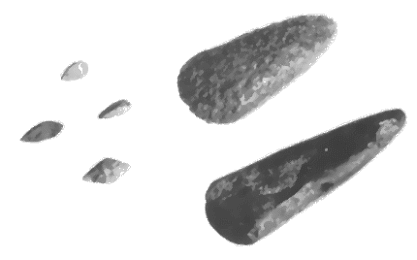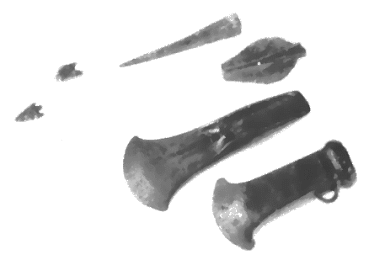Worlebury: Before the Iron Age
During the Ice Ages, the sea-level was alternately lower and higher than it is today. On Worlebury, animals such as giant deer, woolly mammoth and two species of rhinoceros, were living. Quarrying has revealed fragments of their bones and teeth, which were washed into natural fissures and caves. When the sea-level was about 13.5 m higher than it is today, it formed a 'raised beach' in the cliffs near the Toll Road and teeth of horses and hyaena have been found here.
Palaeolithic/Mesolithic to Neolithic
The first evidence of human presence on Worlebury, comes from flints dating to the Palaeolithic/Mesolithic transitional period. Leaf-shaped arrowheads, flint knives, flint scrapers and two stone axes have also been discovered here and date back to the Neolithic period.
Numerous in quantity, these finds suggest that people were occupying the hill, but no definite visible earthworks, such as burial mounds, survive.

Neolithic flint arrowheads and stone axes from Worlebury.
Bronze Age
Evidence of human occupation during the Bronze Age is provided by burial urns dug up on the slopes of Worlebury, in Ashcombe. Examples of bronze work found on the hill include: spearheads, a palstave and a socketed axe. However, flint was still being used, especially for barbed-and-tanged arrowheads.

Flint arrowheads, bronze spearheads and axe heads of Bronze Age.
 On to The Iron Age in Britain....
On to The Iron Age in Britain....
 Back to the Main Page....
Back to the Main Page....
Text by Jane Allwood, HTMLised by Stephen Jenkins
Last modified: Tue Apr 16 18:22:56 BST 1996


 On to The Iron Age in Britain....
On to The Iron Age in Britain.... Back to the Main Page....
Back to the Main Page....